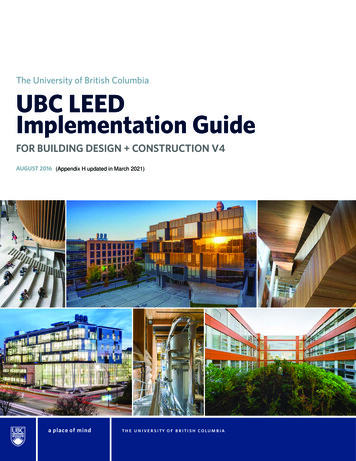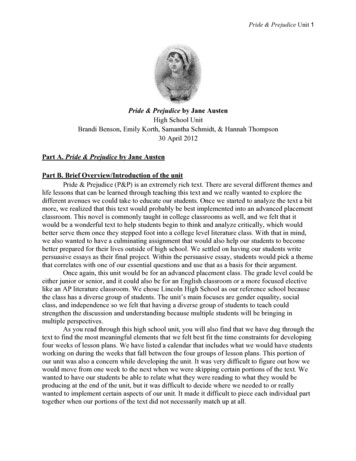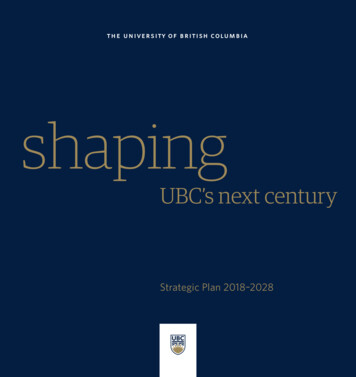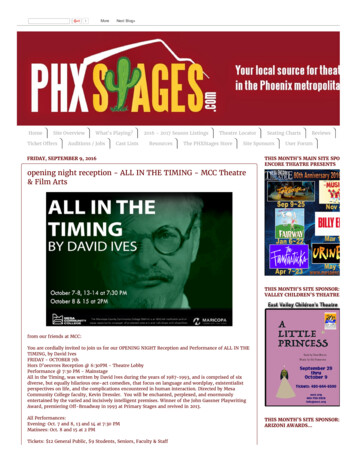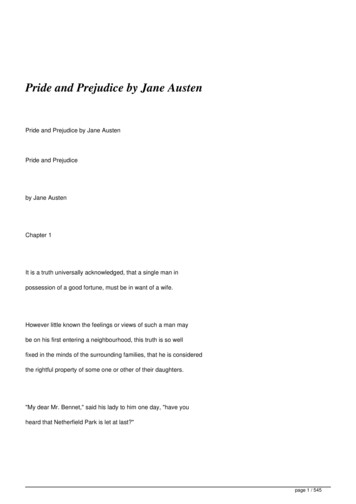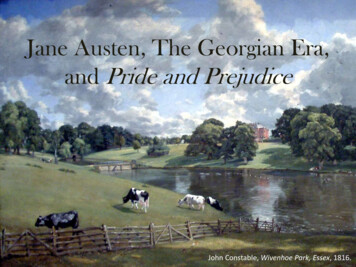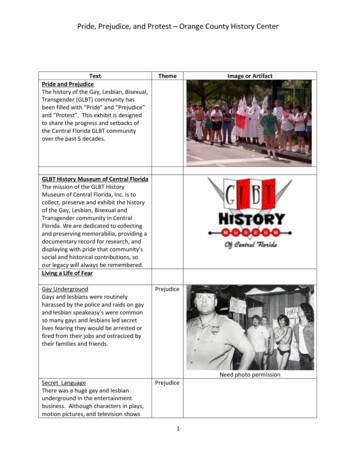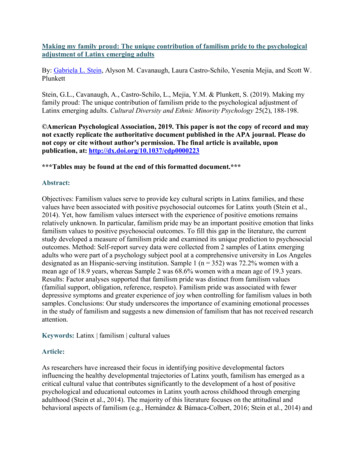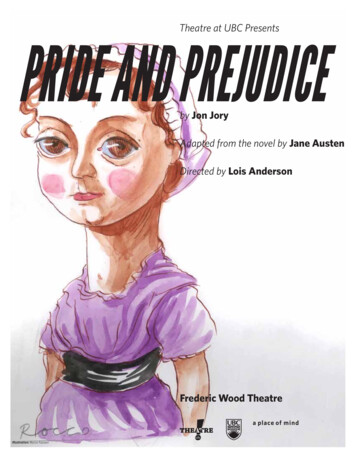
Transcription
Theatre at UBC PresentsPride and Prejudiceby Jon JoryAdapted from the novel by Jane AustenDirected by Lois AndersonFrederic Wood TheatreIllustration: Rocco Fazzari
TICKETS AVAILABLE ATTHECULTCH.COMOR 604-251-1363
A Companion Guide toPride and Prejudiceby Jon JoryAdapted from the novel by Jane AustenDirected by Lois Anderson
Theatre at UBCI can’t go on, I’ll go on (*)After a peripatetic stint of sleeping on various (now) alumni’s couches, floorsand at one point a bathtub (I think it was a bathtub), I sensed a change wasneeded.I did various odd jobs, got a bachelor apartment at the corner of Hastings andMain, and it was there that I read my first Beckett play, Endgame. Aroundthe same time, faculty member Bob Eberle took pity on me and let me use hisfancy Apple IIc computer. This little act of kindness was a turning point in mycareer. I spent many long hours (often till two a.m.) teaching myself computerskills by what I refer to as the brute force approach. I literally tried every menuitem, clicked every button in every program until I figured out what it all did.And thus, I became a computer wiz. I still feel I owe Bob some royalties for anypay I have received over the years—the number of times Bob would call mein the morning and say “What have you done to my computer?!” and I wouldcome in looking calm and cool, then nervously push all the buttons until it wasworking again.It was my computer skills and Bob Eberle’s somewhat blinded view that“Vanderwoude can get any computer working again!” which landed me thejob in the box office in 1996. I was then given a hand up into management byMarietta Kozak in 2002. When she decided to leave her post in 2005, I wasasked by Robert Gardiner if I could do the Admin job. Terrified, I replied “I’lldo the job for two weeks, that’s it!” and that was 8 years ago. Time does fly whenyou are having fun.To the staff of our department I give my warmest thanks. You are the mosttalented group of folks I have ever had the privilege of working for. I shall missthe banter, the laughs and that opening night energy.Image: Gerald at Omar Diaz’s house party 1989. Photo by Roland Brand.Dear Theatre at UBC Patrons: Welcome to our final production of 2013,Jon Jory’s adaptation of Jane Austen’s Pride and Prejudice. This is also the finalproduction for me, Gerald Vanderwoude, at the helm of the ship known as theDepartment of Theatre and Film. Since 1988 I have been in this building, firstas a master’s student (Directing), then as the box office clerk, then manager,then alumnus (I hold the record for the longest Masters student in the historyof UBC!), and finally the administrator of the department. I have spent most ofmy adult life here and have enjoyed my time immensely. On December 1st, 2013I will move on to my new position at UBC, Assistant Dean of Arts.It is fitting, somehow, that Pride and Prejudice is directed by one of mycontemporaries, Ms. Lois Anderson. Lois and I were of the same generationback in the eighties when things were well the eighties. In those days, Iactually lived downstairs in this theatre for the first 8 months of my degree(my brother lived in Delta and the commute was a killer). My time living inthe Freddy Wood ended abruptly with the surprise arrival of Little FlowerAcademy on a school tour. Around twenty or so young ladies in matchingoutfits came wandering into the design room, in time to catch me sitting on adesk, having my morning smoke, still in my tighty-whities. I can still hear theboom of Ian Pratt’s voice saying, “Right Vanderwoude You gotta go!”2To the vast array of students I have seen over the years, more thanks. Yourenergy and boundless optimism have kept me young and a believer in futureworlds.To the Theatre patrons, thanks for coming, for calling me up (those that have)and for taking part in such a wonderful experiment called theatre. I can stillrecall where most of you like to sit in the theatre.To the Faculty: thanks for giving me the opportunity to help and to learn. Ihave had the bird’s eye view of your research and I have been enriched for it.I have two final things to say before they bring the hook.To the three women administrators who came before me: Marjorie Fordham,Margaret Specht, Marietta Kozak: my sincerest thanks. I benefitted mightilyfrom their work and hope I have left the house in good order.I reserve my penultimate comment for parents of aspiring thespians. Overthe years I have given many departmental tours to young students and theirparents. The students are often eager, full of hope for the future while theparents are looking nervously around, wondering if their child is embarkingon a career of hardship and possible financial ruin. I am often asked “What arethe career possibilities for someone in the theatre?” The truthful answer is: Idon’t know. But I will tell you this: everything I have in my life — my job, my
Pride and PrejudiceDirector’s Notesmarriage, my career, even my kids, was made possible because of my time inthe theatre. Theatre taught me all the right lessons of compassion, creativity,humanity, and lightness of being and in turn, gave me the opportunities for afull and rewarding life.I don’t know the answer because theatre teaches you how to embrace allpossibilities. All you have to do is choose. Farewell and Good night!Gerald VanderwoudeOutgoing Administrator, UBC Theatre and FilmIn the spring of 2012 I had the pleasure of teaching a “CreatingTheatre” course here at UBC. The students in the class were in their earlytwenties. They devised scenes around the story of Grimm’s Cinderella andvarious themes surfaced. When I asked the students what they most wanted toexamine in our Final Presentation they said: Love. I was surprised. I thoughtromantic love was a rather tired theme and that most young people simplybelieved that it was there for them to discover. What I didn’t anticipate was thedepth of questioning, fear and hope which surrounded this subject. Is theresuch as thing as long-term love or is it the stuff of myth?Jane Austen wrote her first draft of Pride and Prejudice when she was 21 (under*(the last word goes to Beverly Bardal, who was kind enough to marry me. She is the title First Impressions) and in it she explores love through the adventures ofthe master of great titles and she gave me this Beckett quote. I gave my word that Elizabeth Bennett and her four sisters (Jane, Mary, Kitty and Lydia). She alsoconsiders the theme of self-knowledge and the degree to which the evolutionI would give her full credit and do so here!)of the self, through contact with another, creates the potential for a mature,lasting connection of mind, body and soul. Elizabeth Bennett and Darcy holda mirror up to one another and through their encounters over the course of ayear, they are able to focus a lens on themselves, to question and critique theirown thoughts and opinions and to evolve as individuals. “Til this moment Inever knew myself ”, discovers Lizzie.Jane Austen’s EnglandThe Pride and Prejudice characters all represent various degrees of selfunderstanding and their relationships mirror this depth or shallowness. Mr.and Mrs. Bennett have an unequal marriage – there is affection but no unionof mind or sensibilities. Darcy and Elizabeth will change the expectations ofromantic love – and we know that they will continue to wrestle, banter, discuss,push each other, laugh and love as they journey forward into the future. Theycarve out a deep and vibrant foundation.To direct this pack of passionate, intelligent twenty years olds in a story aboutcharacters their own age has been a sheer delight for me. 1813, or 2013 thestories are the same, even though the world has changed. I want to thankShelby for our fabulous set design conversations throughout the summer andthe design and stage management teams for bringing the world of this play tothe Freddy Wood Stage. Special thanks to Keith Smith and the scene shop.Lois AndersonDirector, Pride and PrejudiceImage: Travel is an important part of Austen’s novel. This map shows the real andimaginary places in the novel. Map by Patrick Wilson. From Where’s Where inJane Austen . and What Happens There. Published by the Jane Austen Societyof Australia and used with permission.3
Theatre at UBCA Universally Unacknowledged Truth:Women and the Want of Money in Pride and Prejudice“It is a truth universally acknowledged, that a single man inpossession of a good fortune must be in want of a wife” (43). So beginsone of the most famous opening sentences in the history of the English novel.Evident is Austen’s characteristic eloquence and economy, but as we continueto read the sentence introduces both irony and critique. The next sentencedestabilizes the “truth universally acknowledged,” insofar as we learn moreprecisely for whom this statement “must be” true:However little known the feelings or views of such a man may be onhis first entering a neighbourhood, this truth is so well fixed in theminds of the surrounding families, that he is considered as the rightfulproperty of some one or other of their daughters (43).In Jon Jory’s adaption, it is the younger sisters who voice the novel’s openinglines; and Elizabeth who reminds the audience that this “universal truth”belongs to those who are most anxious for the future of their daughters,Image: Chatworth House, the estate used as Darcy’s Pemberly in the BBC’sparticularly those who are portionless (or near portionless). Austen’s ironicPride and Prejudice series. Photo by Rob Bendall. Source: wikicommonsmeaning is revealed, suggesting the following, more accurate formulation: “It isinsecurity of many women in her class. The entail was a legal device useda universally acknowledge truth that, a single woman without possession of ato prevent property from being broken up (either by selling off parts of it,fortune, must be in want of a husband.”or subdividing it amongst heirs), or descending to a female line, or both. Inessence, the entail formalized the practice of primogeniture, the widespreadIn both the novel and the play, Mrs. Bennet intervenes to remind us that itpractice of leaving property entirely to one’s eldest son. This system preservedis mothers who are most anxious for their daughters: “A single man of largethe land-holdings of the gentry and nobility, whose affluence was based onfortune; four or five thousand a year. What a fine thing for our girls!” Thusthe “universal truth” has been reduced to a mother’s apparently crass desire to land-ownership, with income earned by leasing the land. Darcy’s vast estate,marry her daughters to the first rich man to arrive in the county. For the novel which brings in 10,000 a year, would have placed him amongst a small circle(and the play) begin with Mrs. Bennet’s eagerness to welcome Mr. Bingley (“the of roughly 400 elite families (Heldman); whereas Mr. Bingley, whose moneywas earned (by his father) through trade, is looking to purchase a family estate,single man” of “good fortune” whom the narrator has in mind). Also in thisopening scene, Austen reminds us that Mrs. Bennet cannot put herself (and her and so buy his way into the gentry. Darcy’s estate has been preserved for himdaughters) forward, but must wait for her husband to do so – yet another hint because his ancestors had not subdivided it. Similarly, had any of the propertybeen bequeathed to daughters, the property would have become their husbandsat the constraints operating on women in the period.upon marriage through the common law doctrine of coverture (whereby, uponBy ironically deconstructing this “universal truth,” Austen is not merely being marriage, a woman’s legal rights were subsumed by those of her husband). Theprejudice against women inheriting was based on this legal principle – since itwitty. Rather, she is pointing to a fundamental injustice in her society, one inwhich property was secured to men rather than women, with the consequence resulted (in the event of marriage) of property passing out of the (male) familyline altogether.that women’s lives had to revolve around obtaining a suitable husband. Afurther irony is also hinted at here and throughout the novel — that societycompels most women, at a very young age, to find marriage partners, but at the Provisions were usually made for women from the wealthiest families: Ladysame time it denies them the ability to pursue their objects directly: just as Mrs. Catherine de Bourgh and Georgiana Darcy are, for example, amply taken careof (more on that in a moment). Younger sons, who could not expect to inheritBennet cannot visit Mr. Bingely, so too Elizabeth Bennet, at the Netherfieldproperty, had the professions open to them – and we find many a second sonBall, must wait to be asked to dance. Yet at the same time women cannot betoo passive – Jane almost loses Bingley because she isn’t demonstrative enough. in Austen’s fictional universe who become clergymen (Edward Ferrars in SenseWomen were required to be neither too flirtatious (like Lydia) nor too demure and Sensibility; Edmund Bertram in Mansfield Park); or enter the law (JohnKnightley in Emma). Austen’s own brothers took the third option for men of(like Jane), and though this is a position Elizabeth seems to fill perfectly, it istheir class, entering the military (in their case, the navy). But women of thelargely because she shares the narrator’s ironic detachment, possessing thelesser gentry (like the Bennet sisters, and indeed, like Austen herself) were atability to reflect, at various moments, upon the absurdity of her social worldconsiderable risk, particularly after the death of their fathers “when I am dead,”and her place within it.Mr. Bennet tells his wife and daughters, Mr. Collins “may turn you all out ofThough Elizabeth attempts to distance herself from the realities of the Bennet’s this house as soon as he pleases” (96). (Lest you think this is an exaggeration,you might consult Austen’s first novel, Sense and Sensibility, in which, “[n]future economic prospects, Austen (through characters like Mrs. Bennet ando sooner was his father’s funeral over,” than the eldest son sends his wife andCharlotte Lucas) makes palpable the extreme economic pressure brought tochild to the family estate, effectively dispossessing his step-mother and halfbear on women of the landed classes. By inventing a family of five daughters,with an estate entailed to the next male heir, Austen underscores the economic sisters: 43-44). Though Mrs. Bennet is described as being “beyond the reach4
Pride and Prejudicecircumscribe women). Mr. Bennet’s fails to make provision for his daughters,and to restrain his younger daughters, nearly bringing ruin upon the entirefamily. So too does the narrator reference Sir William Lucas’s recklessness,a father who abandons his lucrative business after having been knighted. Itwas a “distinction,” the narrator dryly tells us, that “had perhaps been felt toostrongly. It had given him a disgust to his business ” (56). Like the Bingleys’,Sir Lucas wishes to avoid the so-called “taint” of trade; but unlike the Bingleys,The Bennet women’s looming homelessness, and indigence, must inform ourunderstanding of Elizabeth’s refusals of marriage, first of Mr. Collins, and then he does not have enough money to do so without harm to his children.of Darcy. At best, after Mr. Bennet’s death, Mrs. Bennet would have 450 a year Some men, like Wickham, are downright villainous – not satisfied with the(the income stream from the 9,000 she has from an inheritance and marriage many opportunities provided to him, he attempts to plot an elopement withGeorgiana Darcy to gain control of her spectacular fortune of 30,000. Heresettlement) (Heldman); this amount is far below Mr. Bennet’s annual incomeAusten reflects on the dangers for women with too much money (Wickhamof 2,000 (and out of the 450 Mrs. Bennet would have to pay for lodging,also preys upon another heiress, and extorts money from Darcy in exchange forwhich Mr. Bennet obviously does not). Austen’s means us to value Elizabeth’srefusal to marry without love – but at the same time we mustn’t lose sight of the marrying Lydia).audacity of her actions, as either marriage could have rescued not only herselfAusten depicts how the very few older women with economic power – usuallybut her mother and sisters. Austen wants us to understand that the risks ofwidows – can abuse it. In seeking to join together two elite families throughboth acceptance and refusal are intolerable.marriage, Lady Catherine demonstrates how far class identity trumps anykind of solidarity among women. One of the most astounding moments ofWithout the prospect of an inheritance and few respectable means of earningconfrontation staged in the novel (and play) occurs during Lady Catherine’smoney, Austen’s novels dramatize Mary Wollstonecraft’s assertion in Thevisit to Longbourn, when Elizabeth refuses to bow to Lady Catherine’sVindication of the Rights of Women (1792) that “the only way women can risewill and feistily protests her insults, which culminate in her aspersion thatin the world — by marriage” (83) — though none of the other five novels“the shades of Pemberley will be “polluted” should she marry Darcy (358).feature such a stupendous rise as Pride and Prejudice, in which the heroine iscatapulted into riches that Mrs. Bennet only slightly exaggerates: “how rich and Instead, Elizabeth asserts her equality with Darcy: “He is a gentleman; I am agentleman’s daughter; so far we are equal” (357). In this way, Austen, throughhow great you will be! What pin-money, what jewels, what carriages you willhave! A house in town! Every thing that is charming!” (377). For women like her heroine, repudiates the further consolidation of power in the hands of thethe Bennet sisters, even to maintain their status, marriage was imperative, and few, demanding that those who were attached to the gentry (but were unable,for a less fortunate women like Charlotte Lucas, it means the acceptance of men through no fault of there own, to hold wealth and property) had the right –based on nothing more than what Wollstonecraft called a woman’s “character aslike the “odious” Mr. Collins, as “the only provision for well-educated younga human being” — to remain, and even rise, within it (82).women of small fortune,” particularly for one at “the age of twenty-seven,without having ever been handsome.” Elizabeth’s inability to accept her friend’sMichelle Levy is an associate professor of English at Simon Fraser University,compromise provides one example of how often women’s limited prospectswhere she teaches and writes about the astounding literature of the Britishcould set them against each other (we also find evidence of these strains inRomantic period. Ever since the discovery of her father’s college copy of PrideElizabeth’s relationship with her mother, and again when Lydia runs off withand Prejudice, at age 16, her favourite author has been Jane Austen.Wickham, her sunken reputation threatening to ruin all of her sisters).of reason” about the entail, “continu[ing] to rail bitterly against the crueltyof settling an estate away from a family of five daughters, in favour of a manwhom nobody cared anything about” (96-97), she almost certainly expressesAusten’s own indignation at an economic system that disadvantaged women atevery turn.One of the problems with women’s dependency on marriage was that, froma young age, women were socialized and educated with this single-mindedpurpose. In The Vindication, Wollstonecraft laments “the neglected educationof my fellow-creatures,” which she identifies as the root cause of women’smisery (79). For Wollstonecraft, women are not born shallow and stupid, butrather “are rendered weak and wretched” by “a false system of education” (79).Women are thus made into animals and children, with their entire upbringingdevoted to making them attractive to men rather than developing their minds.Thus women are taught at best “a smattering of accomplishments” (83) — toplay music, sew, dance, draw — intended to make them pleasing to men butnot to develop their faculties. Some debunking of the ideal “accomplishedwoman” is delivered, by Elizabeth, in the conversation at Netherfield; but it isthrough Lydia that Austen dramatizes the truth of Wollstonecraft’s worst fearsabout what this “false system of education” inflicts on young women.Works CitedWho was responsible for this state of affairs? Like Wollstonecraft, Austenpoints to men (who made the laws and customs that so disadvantage andWollstonecraft, Mary. The Vindication of the Rights of Women. Ed. MiriamBrody. London: Penguin, 1993.Austen, Jane. Sense and Sensibility. Ed. Kathleen James-Cavan. Peterborough,Ontario: Broadview Press, 2001.---, Pride and Prejudice. Ed. Robert P. Irvine. Peterborough, Ontario:Broadview Press, 2002.Butler, Marilyn. ‘Austen, Jane (1775–1817)’, Oxford Dictionary of NationalBiography, Oxford University Press, 2004; online edn, Jan 2010 [http://www.oxforddnb.com/view/article/904, accessed 30 Oct 2013]Heldman, James. “How Wealthy is Mr. Darcy – Really?: Pounds and Dollars inthe World of Pride and Prejudice” Persuasions 12 (1990): 38-49.5
Theatre at UBCBiography of Jane AustenImage: The cottage that Austen lived in when she wrote most of her work. Photo by Jaotg. Source: wikicommonsJane Austen was an English novelist born on December 16th 1775.Through social observation and insights, Austen’s romantic fictions exploredthe lives of English middle and upper class women of the early 19th century.Her distinctive realistic writing style is embedded with irony and socialcommentary that has led her to become one of the most widely read writersin English literature. Some of Austen’s works include Sense and Sensibility,which appeared in 1811, Pride and Prejudice (1813), which received mainstreamsuccess, Mansfield Park (1814) and Emma, which was dedicated to the princeregent, an admirer of her work, in 1815 (BBC History: Jane Austen, Irvine38). After the death of Austen’s father, her family struggled with economichardships and moved several times. The majority of her works were onlycompleted once she and her mother and sister finally had stable housing in1809 (Irvine 37).On December 2, 1802, Austen accepted the proposal of Harris Bigg-Wither, “astuttering, awkward man, six years younger than herself ” (Butler). Then agedtwenty-seven, and living with parents in rented lodgings in Bath, the marriagewould have provided for herself, her sister Cassandra, and even her parents.The next morning, Austen retracted her acceptance, and (with Cassandra)remained unmarried. So little is known about this episode (as is the case withso many) in Austen’s, but it is tempting to compare it to the kind of marriageof convenience Mr. Collins offered, first to Elizabeth and then to Charlotte(it is almost certain that Austen did not love Bigg-Wither). In 1801, Austen’s6father, a clergyman, had surrendered his living in to the eldest son, James, andmoved the family to rented lodgings in Bath. So began a peripatetic lifestyle,one that became more worrisome in 1805, when her father suddenly died.The immediate consequence was that “Mrs Austen, Cassandra, and Jane werecaught in the familiar trap for dependent women of the professional classeswhen they lost the male breadwinner” (Butler). It fell to Austen’s brothers tosupplement Mrs. Austen’s income of 210. With an additional 250 contributedby her brothers, the income for the women was around 460 – an amount veryclose to the 450 a year Mrs. Bennet would have after Mr. Bennet’s death, a sumconsidered most inadequate to support her family. It was not until Austen’sbrother Edward found at cottage in the centre of the small village of Chawton,in Hampshire (only a short distance from his estate) that the women weresettled, and it was “from this point Austen’s career as a published writer couldbegin” (Butler).And of course it was as a published author that Austen sought one of theonly respectable means by which women could rise in the world other thanthrough marriage though, as we will see, it was rising on a very modest scale.Austen’s first novel, Sense and Sensibility, was published in 1811, and she soldthe copyright to Pride and Prejudice to Egerton (who had brought out her firstnovel) in the autumn of 1812 for 110, though she had hoped for 150. Sale ofcopyright was generally the preferred method of publication as it protected anauthor from any losses (Fergus, 16-17) – but in this case it prevented Austen
Pride and Prejudicefrom fully sharing in the profits of novel’s success. And indeed, Pride andPrejudice was “the runaway success among her publications”; published in early1813, the first edition (of perhaps 1500 copies) sold out, thus allowing Egerton toprint a second edition in October 1813 and a third in 1817 (Butler) from whichhe is estimated to have made more than 450 profit on the first two editionsalone (Fergus, 21). But Austen received no payments for these subsequenteditions as she had sold her rights to Egerton. It is estimated in her lifetimeshe received something between 630 and 668 (Fergus, 28; Butler); not aninsignificant sum for a family of women living on a small, fixed income, butunlike her most famous heroine, it was far less than she deserved.In 1816, Jane fell ill, probably due to Addison’s disease. She traveled toWinchester to receive treatment, and died there on 18 July 1817 (BBC History:Jane Austen). Two more novels, Persuasion and Northanger Abbey werepublished posthumously and a final novel was left incomplete. All Austen’snovels were published anonymously.Works CitedButler, Marilyn. “Austen, Jane (1775–1817).” Oxford Dictionary of NationalBiography. Oxford University Press, 2004; online edn, Jan 2010.Web. 30 Oct. 2013.Fergus, Jan. “The Professional Women Writer” The Cambridge Companion toJane Austen. Cambridge: Cambridge University Press, 1997. 12-31. Print.Irvine, Robert P. “Jane Austen and her time: a Brief Chronology.” Pride andPrejudice. Ed. Robert P. Irvine. Toronto: Broadview Press, 2002. 36-8. Print.“Jane Austen (1775 - 1817).” BBC-History. BBC, 2013. Web. 2 Nov. 2013.Biography compiled by Lindsay Lachance with thanks to Michelle LevyCharacter MapImage: This map shows the connections between characters in the novel. http://commons.wikimedia.org/wiki/File:Pride and Prejudice Character Map.png7
Theatre at UBCConceptualizing MoneyImage: The Bank of England will issue a new 10 note in 2016 featuring Jane Austen. Image courtesy Bank of England. Used with permission.In 1807, Jane Austen lived on approximately 44; we know this because she Works Citedkept a detailed record of all her expenses, down to the halfpenny (Hume 291).Eliasen, Alan. “Historical Currency Conversions”. Frink Server Pages. n.d. Web.Hume estimates that the Bennet family would have been in the top 0.17%http://futureboy.us/fsp/dollar.fsp?quantity 10000¤cy pounds&fromYeincome bracket in England at the time, Bingley was in the top 0.1% and Darcy’s ar 1815income put him in the top 0.02% (297).“Daily Currency Converter.” Bank of Canada. 2013. Web.Selena aily-converter/Hume, Robert D. “Money in Jane Austen.” The Review of English Studies 64.254(2012): 289-309. Print.8
Pride and PrejudiceSums of Money Mentioned inJon Jory’s Pride and PrejudiceGBP in 18152013 CDNRelative Purchasing Power ( CDN) (Hume 303)“her equal share of the 5 thousand pounds”Amount to be split up between the 5 Bennetdaughters after their father’s death1,000 82,489.80 166,260.00 – 249,390.00“4 or 5 thousand pounds!”-Bingley’s yearlyincome4,000 – 5,000 329,959.03 – 412,448.79 665,040.00 – 1,246,950.00“10 thousand pounds!”-Darcy’s yearly income10,000 824,897.58 1,662,600.00 – 2,493,900.00“100 per year”-Amount Mr. Bennet agrees togive Lydia once she marries100 7,563.97 16,626.00 – 24,939.00Table: Sums of money mentioned in Jon Jory’s Pride and Predjudice and their modern equivalents.About Jon JoryActor, director and playwright Jon Jory has adapted Austen’s classicnovel into a fast-paced and charming new text. Jory received his Actor’sEquity card as a young child and he later stood at the forefront of the regionaltheater movement of the 1960s. The regional theater movement expandedthe touring circuit, and allowed for new theatres to be opened in more ruralareas, to show that not all theatre talent was in New York City and Los Angeles.Jory was artistic director of the Long Wharf Theater from 1965 to 1966, andin 1969 he took over the Actors Theater of Louisville. Under his leadership, itbecame one of the top theaters in the country. Jory’s major accomplishmentwas the foundation and cultivation of the annual Humana Festival of NewAmerican Plays in Louisville, beginning in 1976 (The Playwrights Database).Jory retired from Actors Theatre in 2000 and that fall, he joined the facultyat the University of Washington School of Drama where he taught acting anddirecting (SFUAD). In 2010 he was made Chairman of the Performing ArtsDepartment at Santa Fe University of Art and Design.Works Cited“Jon Jory (1938-).” The Playwrights Database. doolee.com, 2003. Web. 2 Nov.2013.“Jon Jory.” Faculty. Sante Fe University of Art and Design, 2012. Web. 2 Nov.2013.9
Theatre at UBCpride and prejudiceby Jon JoryAdapted from the novel by Jane AustenDirected by Lois Anderson*Set Design Shelby BushellLighting Design Chengyan Boon with Robert GardinerCostume Design Chanel McCartneySound Design Scott Zechner with Lois AndersonCA STMorgan ChurlaJane BennetLuke JohnsonMr. Collins/Sir WilliamNicole SekiyaMiss Bingley/Mrs. GardinerNathan CottellMr. BennetMatt KennedyMr. DarcyBethany StanleyMrs. BennetThomas ElmsCol. Fitzwilliam/Officer/Ball Guest/ServantKat McLaughlinElizabeth BennetNaomi VogtLady Catherine de Bourgh/HousekeeperCatherine FergussonCatherine Bennet (Kitty)Daniel MeronMr. Bingley/Mr. GardinerNatasha ZacherMary Bennet/Charl
Director, Pride and Prejudice Director's Notes Pride and Prejudice 3 Image: Travel is an important part of Austen's novel. This map shows the real and imaginary places in the novel. Map by Patrick Wilson. From Where's Where in Jane Austen . and What Happens There. Published by the Jane Austen Society of Australia and used with permission.
